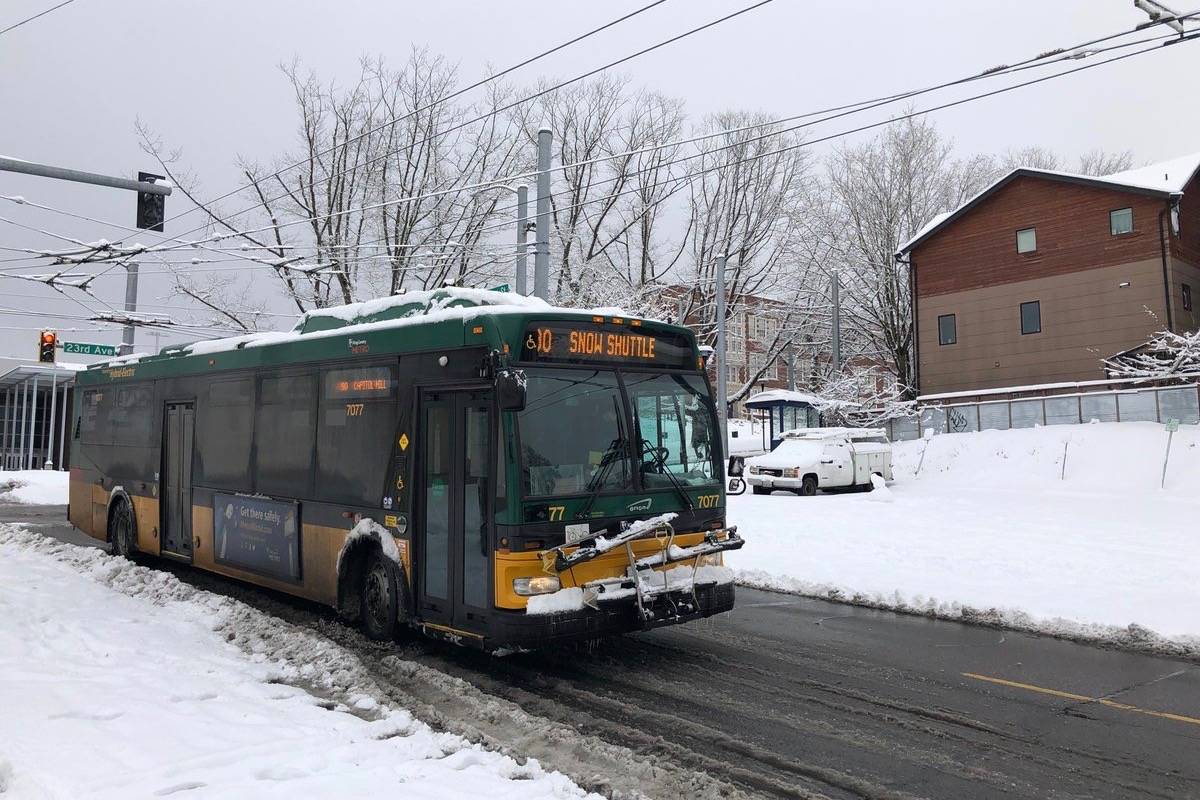Riders should be prepared for crowding and potentially longer waits at bus stops on Monday and Tuesday as Metro operates on the Emergency Snow Network, which reduces service to 60 high-ridership routes to maintain reliability.
Facing unpredictable weather conditions and travel delays, Metro encourages commuters across the region to allow for another 30-60 minutes in their travel schedules and prepare alternate travel plans if their route is not in service, and connect to Link light rail service where possible.
“The region continues to face challenging road conditions, freezing temperatures and a forecast that keeps bringing more and more snow,” said King County Metro General Manager Rob Gannon. “We’re working to provide customers with reliable bus service on an identified network of core routes, and asking riders to prepare for limited transit service until roadway conditions improve and we are out of this cycle of severe winter weather.”
Several more inches of snow are expected and riders are encouraged to monitor weather conditions in their community prior to traveling. Riders also are asked to carefully review their available travel options on the 60 routes and shuttles that will be operating. Buses will be following their posted snow routing except in the event that conditions require taking different streets.
For those who can, Metro is encouraging people to consider opportunities to work from home or flex work schedules on Monday and Tuesday and for as many days as this winter weather persists and affects Metro’s ability to operate safely. This also frees up space on buses for riders who do not have the ability to stay home or change their schedules.
Metro activated its ESN at 4 a.m. Saturday, Feb. 9, and will continue until further notice. Metro’s chained bus fleet has operated for two days on these core routes, which primarily serve key arterials and transit centers in many parts of King County.
The National Weather Service warns of additional weather systems bringing several inches of snow and ongoing freezing temperatures Sunday, Monday and into Tuesday. Metro is monitoring forecasts and roadway conditions to determine whether it is safe and possible to return to a higher level of service and operate a larger network of transit service via snow routes.
Emergency Snow Network
The ESN prioritizes high-ridership routes and serves areas that avoid steep hills. The routes were developed in coordination and collaboration with the City of Seattle and other jurisdictions to follow designated snow plow plans.
Routes operating as part of the ESN will serve core centers around King County, via routes 3, 4, 5, 7, 10, 21, 24, 24 shuttle, 31, 32, 36, 40, 41, 44, 45, 48, 62, 62 shuttle, 65, 70, 75, 90 shuttle, 101, 102 shuttle, 106, 106 shuttle, 120, 124, 128, 150, 166, 168, 169, 180, 181, 235, 245, 248, 252/255 shuttle, 255, 255 shuttle, 271, 331, 345, 348, 348 shuttle, 372 Woodinville and 372 Lake City, ST 522, ST 545, ST 550, ST 554, ST 554 shuttle, RapidRide A, B, C, D, E and F lines.
Metro is monitoring performance of this network and will make adjustments as needed to improve operations. Customers in outlying areas and neighborhoods should prepare for reduced or temporarily unavailable bus service for several days due to inclement weather, difficult travel conditions and topography. Ride2 West Seattle and Eastgate will not operate on Monday and Tuesday.
Maintenance crews continue to switch between chaining operations and troubleshooting and repairing buses damaged by operating in winter weather.
Emergency Snow Network-Access
Access Services will also move to the ESN to mirror fixed route services. Access’ main objective under the ESN will be to provide life sustaining medical transportation. During this time, customers who are not certified to use Access that need to connect to life sustaining medical services can call 206-205-5000 to request services between the hours of 8 a.m. and 5 p.m. Access will also be working closely with fixed route services to help support customers that are stranded due to breakdowns or weather conditions.
What riders should know
Metro encourages people to avoid traveling if at all possible.
Riders who intend to use Metro’s services should visit the Emergency Snow Network webpage to view details about routes in operation and to identify their options. ESN routes will travel on posted snow routes unless otherwise communicated. Metro’s Customer Information Office opens at 6 a.m. Monday to assist riders with trip planning, at 206-553-3000.
Posted timetables on Metro’s Schedules and Maps page are a good point of reference for the 60 ESN routes that are operating, but unforeseen roadway and weather conditions may result in delays or unplanned reroutes.
Customers should be aware that Puget Sound Trip Planner and third-party apps will not reflect ESN service and will not be accurate for planning itineraries on ESN days. However, once intending riders know which ESN route they want to use, other Puget Sound Trip Planner features, such as maps, bus stop locations and timetables for ESN routes are valid. Puget Sound Trip Planner and other apps are still accurate for planning trips or getting schedules for regular service days.
Next Departure and Text for Departure services also may function smoothly for customers when roadway and travel conditions are reliable upstream on the route.


